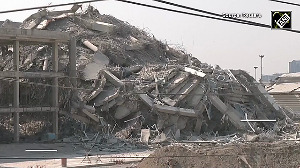A lot has changed since the first man ventured into space in 1961: Pluto is no longer a planet, space tourism is slowly becoming a reality, and NASA just announced it's reviving its mission to interplanetary travel with a new spacecraft named Orion.
The $3.9 billion deal with Lockheed Martin will see the Orion capsule replace the aging Space Shuttle, and NASA hopes to transport humans back to the moon by 2020 -- and later to Mars.
By then, space travel should already have taken off. Since 2001, Virginia-based Space Adventures has been selling an eight-day trip to the Space Station -- round-trip airfare on a Russian shuttle Soyuz included -- for $20 million.
Three people have taken the trip so far, and in September, Anousheh Ansari became the first female space tourist. Given the increased interest in space travel, the Space Adventures is involved in several other projects, including the construction of a massive spaceport in Singapore.
Cheap ship
More than a facility for takeoffs and landings, the Singapore Spaceport will include a museum and a variety of space-related experiences. Visitors will be able to go through G-force training in a centrifuge or take a simulated space walk in a neutral buoyancy tank. Playing on zero gravity, the spaceport's structure will be built to look as if it is floating over a pool of water.
Because only the ultra-rich can pay $20 million for an eight day stay on the International Space Station, entrepreneur Sir Richard Branson has teamed up with Scaled Composites, the California-based aircraft design company, to develop spacecraft
Virgin Galactic and Scaled Composites are currently working on a fleet of SpaceShipTwo spacecraft that would take passengers into sub-orbital space, allowing them to experience weightlessness as well as be able to look back at Earth, at a cost of just $200,000. The first flights are scheduled for 2008.
Hotel expansion
Virgin Galactic plans to house its fleet at Spaceport America, near the town of Truth or Consequences, N.M. The project is backed by the state, which is "investing $100 million," says public information officer Katie Roberts. Roberts says the location was chosen for its "open land and vacancy" and great weather conditions. The site's elevation 4,700 feet above sea level will also make for a shorter trip into space, saving on fuel costs.
Among the other wonders of space is the planned Bigelow Aerospace space hotel. Similar in design to the International Space Station (which has kept a constant human presence in space since 2000), the hotel has a modular design that will allow it easily to expand. The key difference is that the hotel's modules will be inflatable.
Bigelow Aerospace launched the Genesis I test module into orbit on July, 2006, and plans to send Genesis II in early 2007.
The innovative spacecraft, spaceports, and hotels on the drawing board are cause for excitement -- the final frontier may soon be within the reach of more than just professional astronauts and the ultra-rich.






 © 2025
© 2025